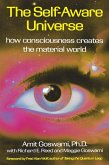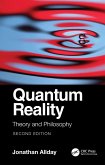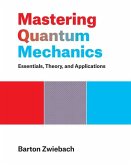S. Rajasekar (Bharathidasan University, Tiruchirapalli, India), R. Velusamy (ANJA College, Tamilnadu, India)
Quantum Mechanics I
The Fundamentals
S. Rajasekar (Bharathidasan University, Tiruchirapalli, India), R. Velusamy (ANJA College, Tamilnadu, India)
Quantum Mechanics I
The Fundamentals
- Broschiertes Buch
- Merkliste
- Auf die Merkliste
- Bewerten Bewerten
- Teilen
- Produkt teilen
- Produkterinnerung
- Produkterinnerung
Quantum Mechanics I: The Fundamentals provides a graduate-level account of the behavior of matter and energy at the molecular, atomic, nuclear, and sub-nuclear levels.
Andere Kunden interessierten sich auch für
![Quantum Mechanics I Quantum Mechanics I]() S. RajasekarQuantum Mechanics I96,99 €
S. RajasekarQuantum Mechanics I96,99 €![The Self-Aware Universe The Self-Aware Universe]() Goswami, Amit, Ph.D.The Self-Aware Universe15,99 €
Goswami, Amit, Ph.D.The Self-Aware Universe15,99 €![Problems in Quantum Mechanics and Field Theory with Mathematical Modelling Problems in Quantum Mechanics and Field Theory with Mathematical Modelling]() Aleksander V. ChichurinProblems in Quantum Mechanics and Field Theory with Mathematical Modelling173,99 €
Aleksander V. ChichurinProblems in Quantum Mechanics and Field Theory with Mathematical Modelling173,99 €![Quantum Mechanics Quantum Mechanics]() Alastair I. M. RaeQuantum Mechanics253,99 €
Alastair I. M. RaeQuantum Mechanics253,99 €![Understanding Quantum Science Understanding Quantum Science]() Steven M. PascalUnderstanding Quantum Science68,99 €
Steven M. PascalUnderstanding Quantum Science68,99 €![Quantum Reality Quantum Reality]() Jonathan AlldayQuantum Reality64,99 €
Jonathan AlldayQuantum Reality64,99 €![Mastering Quantum Mechanics Mastering Quantum Mechanics]() Barton ZwiebachMastering Quantum Mechanics134,99 €
Barton ZwiebachMastering Quantum Mechanics134,99 €-
-
-
Quantum Mechanics I: The Fundamentals provides a graduate-level account of the behavior of matter and energy at the molecular, atomic, nuclear, and sub-nuclear levels.
Hinweis: Dieser Artikel kann nur an eine deutsche Lieferadresse ausgeliefert werden.
Hinweis: Dieser Artikel kann nur an eine deutsche Lieferadresse ausgeliefert werden.
Produktdetails
- Produktdetails
- Verlag: Taylor & Francis Ltd
- 2 ed
- Seitenzahl: 606
- Erscheinungstermin: 30. Januar 2025
- Englisch
- Abmessung: 178mm x 254mm x 35mm
- Gewicht: 1094g
- ISBN-13: 9780367776367
- ISBN-10: 0367776367
- Artikelnr.: 72541804
- Herstellerkennzeichnung
- Libri GmbH
- Europaallee 1
- 36244 Bad Hersfeld
- gpsr@libri.de
- Verlag: Taylor & Francis Ltd
- 2 ed
- Seitenzahl: 606
- Erscheinungstermin: 30. Januar 2025
- Englisch
- Abmessung: 178mm x 254mm x 35mm
- Gewicht: 1094g
- ISBN-13: 9780367776367
- ISBN-10: 0367776367
- Artikelnr.: 72541804
- Herstellerkennzeichnung
- Libri GmbH
- Europaallee 1
- 36244 Bad Hersfeld
- gpsr@libri.de
S. Rajasekar received his B.Sc. and M.Sc. in Physics both from St. Joseph's College, Tiruchirapalli. He was awarded his Ph.D. degree from Bharathidasan University in 1992 under the supervision of Prof. M. Lakshmanan. In 1993, he joined as a Lecturer at the Department of Physics, Manonmaniam Sundaranar University, Tirunelveli. In 2003, the book Nonlinear Dynamics: Integrability, Chaos and Patterns written by Prof. M. Lakshmanan and the author was published by Springer. In 2005, he joined as a Professor at the School of Physics, Bharathidasan University. In 2016 Springer published Nonlinear Resonances written by Prof. Miguel A.F. Sanjuan and the author. In 2021 Professors U.E. Vincent, P.V.E. McClintock, I.A. Khovanov and the author compiled and edited two issues of Philosophical Transactions of the Royal Society A on the theme Vibrational and Stochastic Resonances in Driven Nonlinear Systems. He has also edited Recent Trends in Chaotic, Nonlinear and Complex Dynamics with Professors Jan Awrejecewicz and Minvydas Ragulskis, published by World Scienti¿c in 2022. His recent research focuses on nonlinear dynamics with a special emphasize on nonlinear resonances. He has authored or co-authored more than 120 research papers in nonlinear dynamics. R. Velusamy received his B.Sc. degree in Physics from the Ayya Nadar Janaki Ammal College, Sivakasi in 1972 and M.Sc. in Physics from the P.S.G. Arts and Science College, Coimbatore in 1974. He worked as a demonstrator in the Department of Physics in P.S.G. Arts and Science College during 1974-77. He received an M.S. Degree in Electrical Engineering at Indian Institute of Technology, Chennai in the year 1981. In the same year, he joined in the Ayya Nadar Janaki Ammal College as an Assistant Professor in Physics. He was awarded a M.Phil. degree in Physics in the year 1988. He retired in the year 2010. His research topics are quantum con¿ned systems and wave packet dynamics.
1. Why Was Quantum Mechanics Developed? 2. Schrödinger Equation and Wave
Function. 3. Operators, Eigenvalues and Eigenfunctions. 4. Exactly Solvable
Systems I: Bound States. 5. Exactly Solvable Systems II: Scattering States.
6. Matrix Mechanics. 7. Various Pictures in Quantum Mechanics and Density
Matrix. 8. Heisenberg Uncertainty Principle. 9. Momentum Representation.
10. Wave Packet. 11. Theory of Angular Momentum. 12. Hydrogen Atom. 13.
Approximation Methods I: Time-Independent Perturbation Theory. 14.
Approximation Methods II: Time-Dependent Perturbation Theory. 15.
Approximation Methods III: WKB and Asymptotic Methods. 16. Approximation
Methods IV: Variational Method. 17. Scattering Theory. 18. Identical
Particles. 19. Relativistic Quantum Theory. 20. Mysteries in Quantum
Mechanics. 21. Delayed-Choice Experiments. 22. Fractional Quantum
Mechanics. 23. Numerical Methods for Quantum Mechanics. Appendices. Index.
Function. 3. Operators, Eigenvalues and Eigenfunctions. 4. Exactly Solvable
Systems I: Bound States. 5. Exactly Solvable Systems II: Scattering States.
6. Matrix Mechanics. 7. Various Pictures in Quantum Mechanics and Density
Matrix. 8. Heisenberg Uncertainty Principle. 9. Momentum Representation.
10. Wave Packet. 11. Theory of Angular Momentum. 12. Hydrogen Atom. 13.
Approximation Methods I: Time-Independent Perturbation Theory. 14.
Approximation Methods II: Time-Dependent Perturbation Theory. 15.
Approximation Methods III: WKB and Asymptotic Methods. 16. Approximation
Methods IV: Variational Method. 17. Scattering Theory. 18. Identical
Particles. 19. Relativistic Quantum Theory. 20. Mysteries in Quantum
Mechanics. 21. Delayed-Choice Experiments. 22. Fractional Quantum
Mechanics. 23. Numerical Methods for Quantum Mechanics. Appendices. Index.
1. Why Was Quantum Mechanics Developed? 2. Schrödinger Equation and Wave
Function. 3. Operators, Eigenvalues and Eigenfunctions. 4. Exactly Solvable
Systems I: Bound States. 5. Exactly Solvable Systems II: Scattering States.
6. Matrix Mechanics. 7. Various Pictures in Quantum Mechanics and Density
Matrix. 8. Heisenberg Uncertainty Principle. 9. Momentum Representation.
10. Wave Packet. 11. Theory of Angular Momentum. 12. Hydrogen Atom. 13.
Approximation Methods I: Time-Independent Perturbation Theory. 14.
Approximation Methods II: Time-Dependent Perturbation Theory. 15.
Approximation Methods III: WKB and Asymptotic Methods. 16. Approximation
Methods IV: Variational Method. 17. Scattering Theory. 18. Identical
Particles. 19. Relativistic Quantum Theory. 20. Mysteries in Quantum
Mechanics. 21. Delayed-Choice Experiments. 22. Fractional Quantum
Mechanics. 23. Numerical Methods for Quantum Mechanics. Appendices. Index.
Function. 3. Operators, Eigenvalues and Eigenfunctions. 4. Exactly Solvable
Systems I: Bound States. 5. Exactly Solvable Systems II: Scattering States.
6. Matrix Mechanics. 7. Various Pictures in Quantum Mechanics and Density
Matrix. 8. Heisenberg Uncertainty Principle. 9. Momentum Representation.
10. Wave Packet. 11. Theory of Angular Momentum. 12. Hydrogen Atom. 13.
Approximation Methods I: Time-Independent Perturbation Theory. 14.
Approximation Methods II: Time-Dependent Perturbation Theory. 15.
Approximation Methods III: WKB and Asymptotic Methods. 16. Approximation
Methods IV: Variational Method. 17. Scattering Theory. 18. Identical
Particles. 19. Relativistic Quantum Theory. 20. Mysteries in Quantum
Mechanics. 21. Delayed-Choice Experiments. 22. Fractional Quantum
Mechanics. 23. Numerical Methods for Quantum Mechanics. Appendices. Index.








